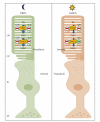Regulation of phosphatidic Acid metabolism by sphingolipids in the central nervous system
- PMID: 21490799
- PMCID: PMC3068476
- DOI: 10.1155/2011/342576
Regulation of phosphatidic Acid metabolism by sphingolipids in the central nervous system
Abstract
This paper explores the way ceramide, sphingosine, ceramide 1-phosphate, and sphingosine 1-phosphate modulate the generation of second lipid messengers from phosphatidic acid in two experimental models of the central nervous system: in vertebrate rod outer segments prepared from dark-adapted retinas as well as in rod outer segments prepared from light-adapted retinas and in rat cerebral cortex synaptosomes under physiological aging conditions. Particular attention is paid to lipid phosphate phosphatase, diacylglycerol lipase, and monoacylglycerol lipase. Based on the findings reported in this paper, it can be concluded that proteins related to phototransduction phenomena are involved in the effects derived from sphingosine 1-phosphate/sphingosine or ceramide 1-phosphate/ceramide and that age-related changes occur in the metabolism of phosphatidic acid from cerebral cortex synaptosomes in the presence of either sphingosine 1-phosphate/sphingosine or ceramide 1-phosphate/ceramide. The present paper demonstrates, in two different models of central nervous system, how sphingolipids influence phosphatidic acid metabolism under different physiological conditions such as light and aging.
Figures



Similar articles
-
Diacylglyceride lipase activity in rod outer segments depends on the illumination state of the retina.Neurochem Int. 2008 Dec;53(6-8):382-8. doi: 10.1016/j.neuint.2008.09.007. Epub 2008 Sep 19. Neurochem Int. 2008. PMID: 18926868
-
Involvement of lysophosphatidic acid, sphingosine 1-phosphate and ceramide 1-phosphate in the metabolization of phosphatidic acid by lipid phosphate phosphatases in bovine rod outer segments.Neurochem Res. 2008 Jul;33(7):1205-15. doi: 10.1007/s11064-007-9569-5. Epub 2008 Feb 21. Neurochem Res. 2008. PMID: 18288612
-
Age-related changes in the metabolization of phosphatidic acid in rat cerebral cortex synaptosomes.Arch Biochem Biophys. 2009 Aug 15;488(2):121-9. doi: 10.1016/j.abb.2009.07.002. Arch Biochem Biophys. 2009. PMID: 19691145
-
Sphingoid bases and phospholipase D activation.Chem Phys Lipids. 1996 May 24;80(1-2):27-36. doi: 10.1016/0009-3084(96)02543-1. Chem Phys Lipids. 1996. PMID: 8681426 Review.
-
Lipid second messengers and related enzymes in vertebrate rod outer segments.J Lipid Res. 2010 Apr;51(4):685-700. doi: 10.1194/jlr.R001891. Epub 2009 Oct 14. J Lipid Res. 2010. PMID: 19828910 Free PMC article. Review.
Cited by
-
Modulation of Insulin Sensitivity of Hepatocytes by the Pharmacological Downregulation of Phospholipase D.Int J Endocrinol. 2015;2015:794838. doi: 10.1155/2015/794838. Epub 2015 May 24. Int J Endocrinol. 2015. PMID: 26089893 Free PMC article.
-
Localized sphingolipid signaling at presynaptic terminals is regulated by calcium influx and promotes recruitment of priming factors.J Neurosci. 2012 Dec 5;32(49):17909-20. doi: 10.1523/JNEUROSCI.2808-12.2012. J Neurosci. 2012. PMID: 23223309 Free PMC article.
References
-
- Baumruker T, Bornancin F, Billich A. The role of sphingosine and ceramide kinases in inflammatory responses. Immunology Letters. 2005;96(2):175–185. - PubMed
-
- Farooqui AA, Horrocks LA, Farooqui T. Interactions between neural membrane glycerophospholipid and sphingolipid mediators: a recipe for neural cell survival or suicide. Journal of Neuroscience Research. 2007;85(9):1834–1850. - PubMed
-
- Hait NC, Oskeritzian CA, Paugh SW, Milstien S, Spiegel S. Sphingosine kinases, sphingosine 1-phosphate, apoptosis and diseases. Biochimica et Biophysica Acta. 2006;1758(12):2016–2026. - PubMed
LinkOut - more resources
Full Text Sources

